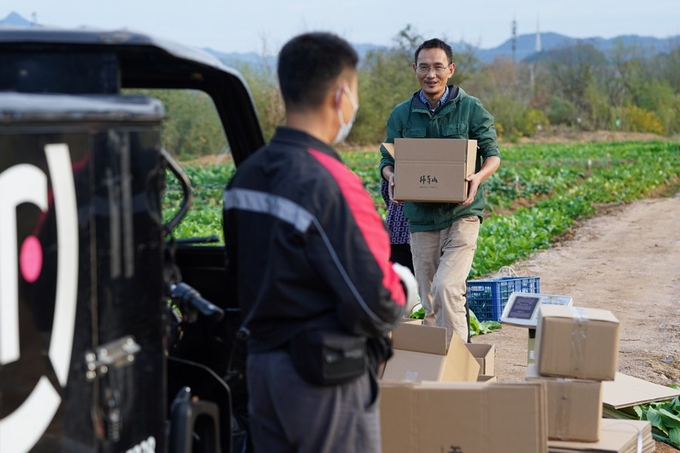June 20, 2025 | 05:53 GMT +7
June 20, 2025 | 05:53 GMT +7
Hotline: 0913.378.918
June 20, 2025 | 05:53 GMT +7
Hotline: 0913.378.918

A farmer hands a box of packaged vegetables to a deliveryman in Yixian county, Huangshan city, East China's Anhui province, Nov 24, 2022. Photo: Xinhua
After a three-year push by the State Post Bureau to expand the nationwide delivery network to include even the most remote parts of the country, some 95 percent of Chinese villages now have access with the rest to follow, the bureau said recently.
With over 100 billion parcels delivered in China last year, the bureau said that it intends to continue its expansion into rural areas this year, and also ensure that the rights of couriers are improved and protected.
China has 990 large parcel delivery centers in rural counties and 278,000 parcel delivery stations located in villages.
The bureau will focus on improving the parcel delivery system in rural counties, towns and villages to consolidate the achievements of the three-year campaign to promote the parcel delivery network in rural areas, said Hou Yanbo, spokesman for the bureau.
It will continue to build parcel delivery centers in counties and villages, and encourage various parcel delivery companies to share more resources in rural areas, he said.
In some rural areas, a single courier can handle parcels from different companies, saving costs and increasing benefits.
As almost all administrative villages across China have access to bus services, the bureau said it has encouraged placing parcels on scheduled buses to rural areas to reduce logistics costs.
Hou said there will also be a greater focus put on improving the protection of couriers' legal rights.
Enterprises have been asked to ensure that they sign work contracts with couriers and make social insurance contributions in accordance with the law. The bureau has also asked companies to come good with their promises to increase delivery fees in order to boost couriers' incomes.
Delivery companies have been encouraged to better handle complaints filed by customers, establishing a system for couriers to defend themselves against unfair complaints, and setting up a counseling hotline for couriers.
China's parcel delivery business has boomed in the past decade. Last year, the country handled 110.5 billion parcels, the most of any country in the world in terms of volume. Among them, about one-third of parcels were collected and delivered in rural areas.
Thanks to the expansion of the parcel delivery network, agricultural produce from rural areas can be delivered and sold more easily in cities, benefiting farmers and their businesses.
(Chinadaily)

(VAN) Poultry production in Poland, which has only started recovering from devastating bird flu outbreaks earlier this year, has been hit by a series of outbreaks of Newcastle disease, with the veterinary situation deteriorating rapidly.

(VAN) Extensive licensing requirements raise concerns about intellectual property theft.

(VAN) As of Friday, a salmonella outbreak linked to a California egg producer had sickened at least 79 people. Of the infected people, 21 hospitalizations were reported, U.S. health officials said.

(VAN) With the war ongoing, many Ukrainian farmers and rural farming families face limited access to their land due to mines and lack the financial resources to purchase needed agricultural inputs.

(VAN) Vikas Rambal has quietly built a $5 billion business empire in manufacturing, property and solar, and catapulted onto the Rich List.

(VAN) Available cropland now at less than five percent, according to latest geospatial assessment from FAO and UNOSAT.

(VAN) Alt Carbon has raised $12 million in a seed round as it plans to scale its carbon dioxide removal work in the South Asian nation.